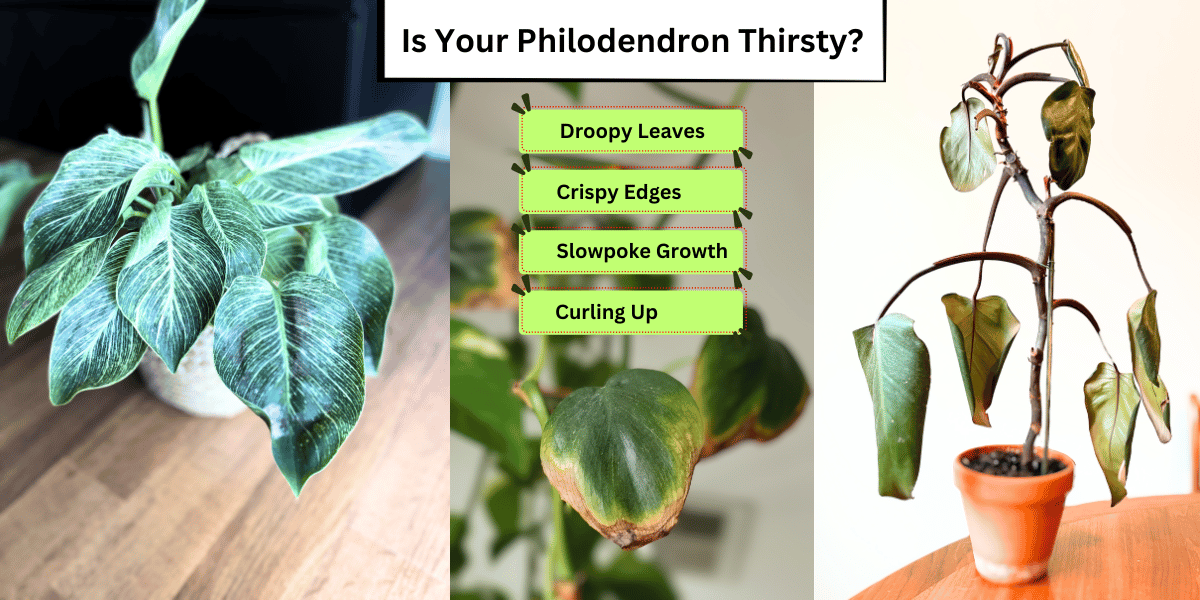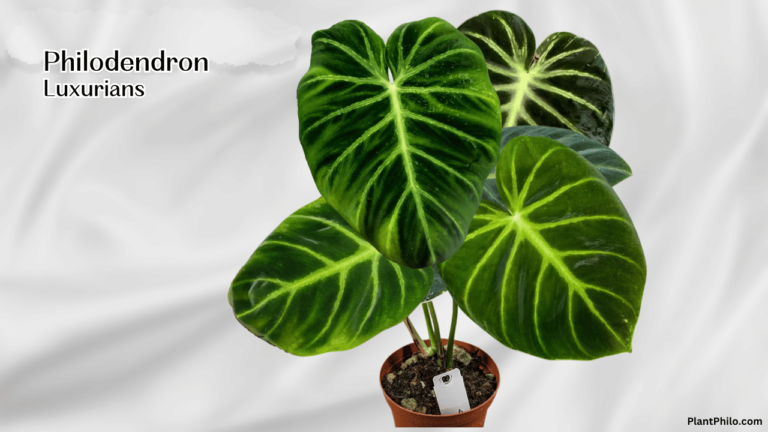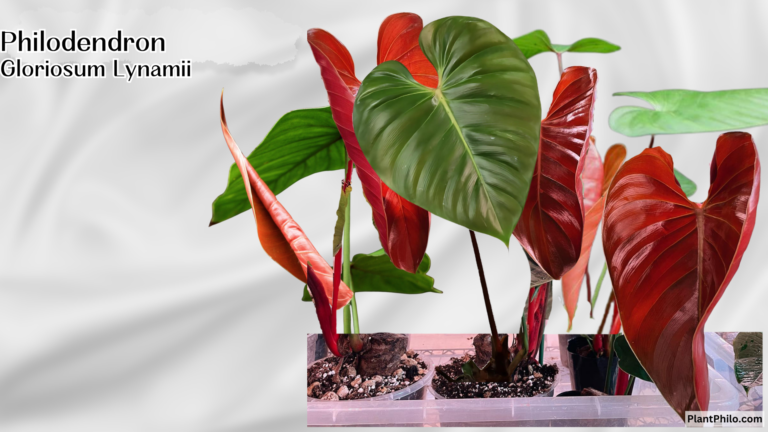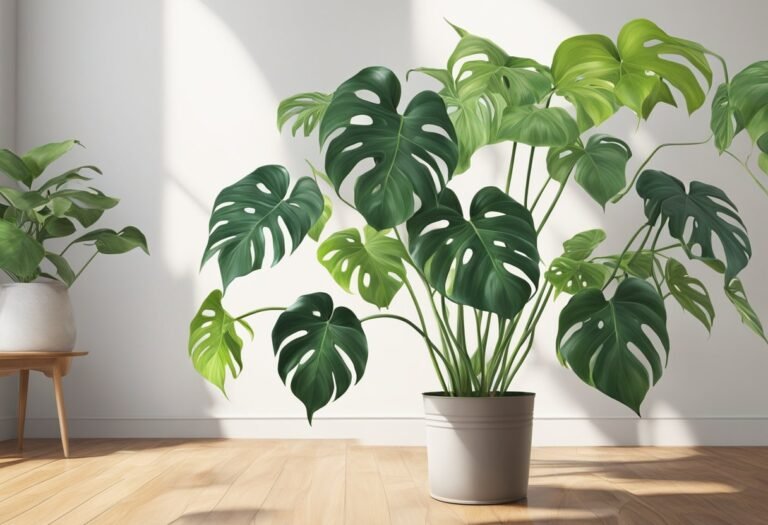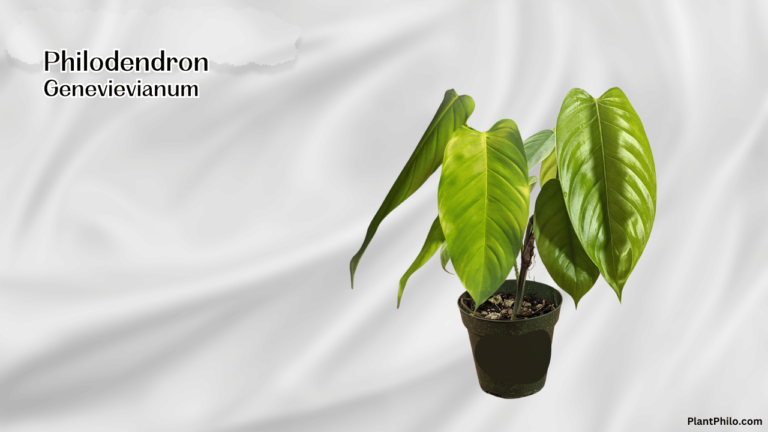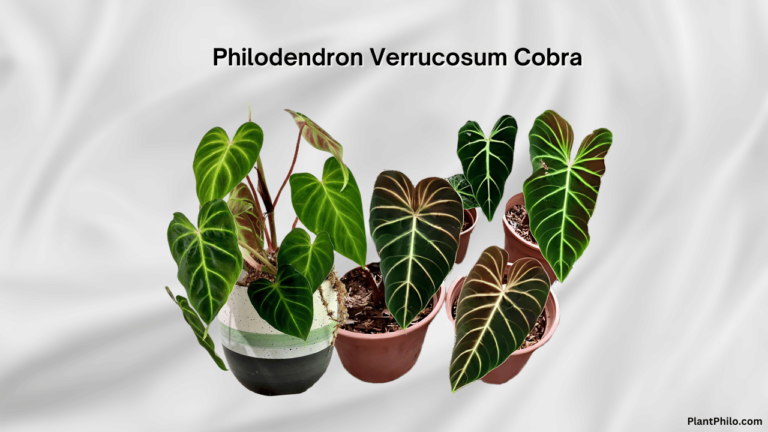Watering Philodendron Plants: When, How Much, & Signs of Trouble
Are you accidentally drowning (or dehydrating) your Philodendron? Is it wilting, yellowing, or just plain sad? It’s time to get your philodendron’s watering schedule right. Say goodbye to droopy leaves and hello to lush foliage with the expert tips that will make you a hydration hero!
Philodendrons are a popular choice among houseplant enthusiasts. They are valued for their lush foliage and adaptability to indoor conditions. Proper watering is critical to keeping your Philodendron healthy and happy.
While these tropical plants enjoy moist soil, they’re also susceptible to problems caused by both overwatering and under-watering. Recognizing the signs of thirst in your Philodendron involves understanding the balance between soil moisture and humidity, factors that contribute to the overall health of your plant.
Developing a watering routine for your Philodendron means paying attention to the specific needs of your plant, which vary depending on the variety and the environment it’s in. The goal is to achieve a level of moisture that mimics the natural habitat of the Philodendron without subjecting the plant to the extremes of waterlogged soil or drought.
By regularly checking the soil for dryness and using the right amount of water, you can maintain the perfect level of moisture to ensure that your Philodendron thrives.
Key Takeaways
- Proper watering is crucial for philodendron health, balancing soil moisture with ambient humidity.
- A philodendron’s watering needs are influenced by its variety and living conditions.
- Monitoring soil dryness and adjusting water accordingly is key to maintaining happy philodendron foliage.
Is Your Philodendron Thirsty? Signs to Watch For
Philodendron plants give clear signs when they need water. Look out for these symptoms to ensure your plant stays hydrated and healthy.
The Droopy Drama Queen
When your Philodendron’s leaves begin to wilt or droop, that’s a theatrical way the plant tells you it’s thirsty. Wilting is one of the most obvious signs that your Philodendron requires watering, and you should check the soil moisture to confirm.
Dry Soil Detective
Inspect the soil by touching the top inch. If it feels dry, it’s time to act. Your Philodendron prefers a consistent level of soil moisture, and a parched soil surface signals the need for a drink.
Crispy Clues
Look out for yellow or brown crispy edges on leaves, which often suggest that your Philodendron has been too dry. This can be a reaction to both under-watering and over-watering, so it’s important to assess the soil before you water.
Slowpoke Growth
If growth seems sluggish and new leaves are smaller than usual, your Philodendron could be expressing its desire for more frequent watering. Slow growth with adequate light and temperature often hints at insufficient soil moisture.
Curling Up
Leaf curling is another sign of dryness in philodendrons. When leaves curl inwards, they are trying to conserve moisture, and this is your cue to check the soil and consider giving your plant a soothing drink.
Understanding Your Philodendron’s Thirst
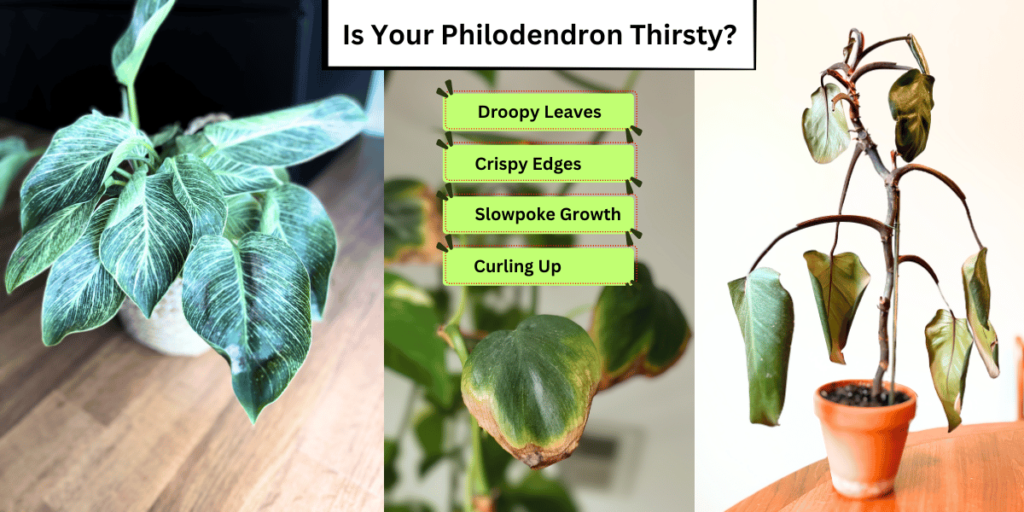
Successfully watering your Philodendron begins with recognizing its unique needs and adapting to them. It’s crucial to balance factors such as water amount, frequency, soil moisture, and seasonal changes to maintain plant health.
Decoding the Signals
Your Philodendron will show clear signs when it’s time to water. If the top inch of the soil feels dry to the touch, it indicates that your plant could use a drink. Conversely, if the leaves are yellowing and the soil is moist, it may suggest that you’ve been too generous with water.
Know Your Variety
Different Philodendron varieties may have varied watering needs. For example, a Philodendron Xanadu prefers consistently moist soil, whereas a Philodendron Hederaceum is more forgiving if you forget to water. Always research your plant’s specific hydration preferences.
Season Matters
- Summer: Philodendrons usually require more water in summer due to higher temperatures and increased evaporation from the soil.
- Winter: During winter, water less frequently as the plant’s growth slows and cooler temperatures allow the soil to retain moisture longer.
The Watering Routine: A Step-by-Step Guide
Proper hydration is key to thriving philodendrons. Your routine should center on consistent checks, correct techniques, and understanding the plant’s needs.
Step 1: The Finger Test
To determine if your Philodendron needs water, perform the finger test. Gently insert your finger into the top 1 to 2 inches of the soil mix. If the soil feels dry, it’s time to hydrate your plant. This simple method can be more reliable than a moisture meter, as it helps you feel the actual soil moisture.
Step 2: Watering Techniques
When watering, slowly pour water at the base of the plant until it seeps out of the drainage holes. Use a saucer or tray to catch excess water, but empty it to prevent the roots from sitting in standing water. This ensures the soil mixture is evenly moist without becoming waterlogged.
Step 3: Watering Frequency
Your watering schedule should adapt to factors like humidity, season, and plant size. Typically, allow the topsoil to dry out slightly between waterings. Overwatering can lead to root rot, so it’s better to water less frequently than to overdo it.
Step 4: Water Quality
Tap water may contain fluoride and other minerals that can harm philodendrons. If possible, use filtered or rainwater for your plants. Ensure the water is at room temperature to prevent shocking the plant’s roots.
Step 5: Choosing the Right Pot
Select a pot with ample drainage holes to allow excess water to escape. Materials matter, too – ceramic pots help soil dry out more evenly, while plastic pots retain moisture longer. Mix materials like perlite, peat moss, and well-draining soil in your potting mix to promote healthy root growth.
Step 6: Humidity Helpers
Philodendrons are tropical plants that prefer a high humidity environment. Increase moisture around your Philodendron by using a humidifier or placing a water-filled tray with pebbles beneath the pot. Occasional misting can also provide temporary humidity boosts, especially during dry, warm months.
Common Watering Mistakes & How to Fix Them
Maintaining the proper moisture level is critical for the health of your Philodendron. Both overwatering and underwatering can lead to negative outcomes such as root rot or dried-out roots. Below, you’ll find common watering mistakes and straightforward strategies to help your Philodendron thrive.
Overwatering
Symptoms:
Your Philodendron might be overwatered if you notice:
- Leaves turning a yellow hue.
- The presence of soft, limp leaves is a classic symptom.
- Root rot, which is noticeable when the roots are brown and mushy.
- An overall appearance of stunted growth in your plant.
Fix:
Firstly, ensure your Philodendron’s pot has adequate drainage holes to allow excess water to escape. If you’ve overwatered, stop watering and let the soil dry. If your plant is severely waterlogged, consider repotting with fresh, well-draining soil. Monitoring soil moisture before watering can prevent future overwatering. Wait until the top inch of the soil feels dry to the touch. To rescue an overwatered Philodendron, ensure you:
- Provide improved drainage to the plant by repotting it in soil with a better mix or making certain the pot has adequate drainage holes.
- Allow the soil to dry out before watering again, and then adjust your routine to avoid excess moisture.
- If root rot has set in, consider trimming away the rotten roots and treating them with a fungicide recommended for root rot before repotting them in fresh soil.
Underwatering
Symptoms:
An underwatered Philodendron often exhibits:
- Leaves that are dry and crispy often turn a brown color.
- Noticeable drooping leaves that struggle to perk up even in ideal light conditions.
Fix:
If your Philodendron is underwatered, slowly reintroduce water. Give it a thorough soak until water runs out of the drainage holes, and then empty the saucer beneath the pot. Going forward, establish a consistent watering schedule, checking the soil’s moisture level at least once a week.
Your Philodendron prefers to dry out slightly between waterings, so allow the top inch of soil to dry before adding more water. To help your underwatered Philodendron recover:
- Begin by thoroughly watering the soil. Make sure that moisture reaches the root zone to promote hydration.
- Going forward, establish a consistent watering schedule. Ensure you check the soil moisture regularly. Water when the top inch of the soil feels dry to the touch.
Root Rot Rescue
Symptoms: Soft, brown roots; a foul smell coming from the pot.
Fix: Root rot is a serious condition often caused by overwatering. To save your plant, remove it from its pot and trim away any affected roots with sterile pruning shears. Use fresh, well-draining soil to repot and make sure the new pot has sufficient drainage.
Allow the soil to dry out more between waterings, and ensure you never let water sit in the saucer, as stagnant water can harm the roots.
Special Considerations for Variegated Philodendrons
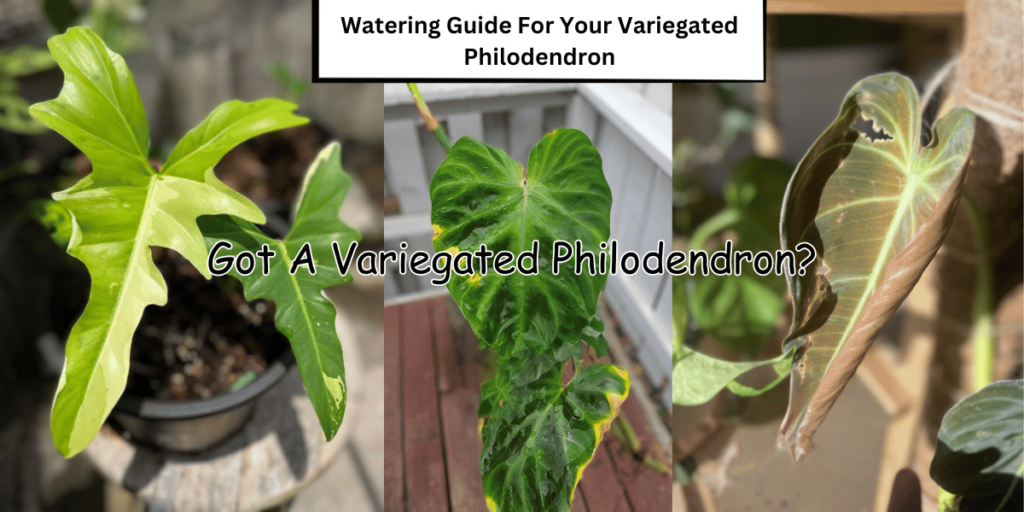
Variegated philodendrons often require more light than their non-variegated counterparts, which can affect their watering needs. Since they are grown primarily for their unique foliage, maintaining a proper watering schedule is crucial for their health and vibrancy.
Thirsty Beauties
Variegated Philodendrons, with their stunning patterns and colors, often need a bit more attention when it comes to watering. Ensure you’re watering when the top inch of soil is dry to the touch. Over-watering can lead to root rot, a common issue for philodendrons.
Why the Extra Care?
The white or lighter-colored parts of the leaves lack chlorophyll, the pigment responsible for photosynthesis. This means they produce less energy, potentially making the plant thirstier. If your plant is in a lower light area, reduce the frequency of watering to prevent soil from staying wet for too long.
Don’t Let Them Dry Out
While you still want to avoid overwatering, be especially vigilant about checking the soil moisture for variegated varieties.Increase watering frequency slightly if your variegated Philodendron is in a higher light area as evaporation occurs faster.
Consistent Moisture
Aim to keep the soil evenly moist but not soggy. This may mean slightly more frequent watering than for all-green philodendrons.
Humidity Boost
Variegated philodendrons particularly appreciate higher humidity levels. Misting or using a pebble tray can be even more beneficial for them. Keep a humidity tray nearby or use a humidifier to maintain a consistent humidity level, as variegated philodendrons can be more sensitive to dry air.
Fertilizer
During the growing season, pair a regular watering schedule with a balanced fertilizer to support healthy growth.
Tips for Successful Watering for Your Philodendrons
When watering your Philodendron, it is crucial to understand the plant’s preference for well-draining soil mix and consistent moisture without waterlogging. Here are practical tips to help you water your houseplant accurately:
- Frequency: Adjust your watering frequency according to the season. During growth periods in spring and summer, water is used once a week; in the dormant period of fall and winter, it is reduced to every other week.
- Time: Water in the morning to allow excess moisture to evaporate during the day.
- Amount: Check the top inch of potting soil; if it’s dry, provide enough water to moisten the soil evenly—usually about one cup (250 ml).
| Season | Watering Guidance |
| Spring/Summer | Weekly, or when the top inch of soil is dry |
| Fall/Winter | Bi-weekly, or adjustment as needed due to lower growth rate |
- Drainage: Ensure your pot has adequate drainage holes. After watering, allow excess water to drain away. If using a saucer, empty it to avoid water sitting beneath the pot.
- Tools: Use a watering can with a spout to target the soil directly and avoid wetting the foliage, which can encourage disease.
- Temperature and Humidity: Philodendrons thrive in warmer temperatures and higher humidity. Consider placing your plant on a pebble tray or use a humidity tray to increase the moisture around the plant, especially if your indoor environment is dry.
- Watering Can: Use a watering can with a narrow spout for precise watering.
- Reduce Water Loss: Group plants together to increase humidity and reduce water loss.
- Consider using a self-watering pot for busy plant owners.
Frequently Asked Questions
In caring for your Philodendron plants, you’ll encounter several common inquiries regarding their watering needs. This section addresses those questions with precise guidance.
How often should you water philodendrons?
Your Philodendron’s watering frequency hinges on various factors, including the environment and soil dryness. Water philodendrons when the top few inches of soil are dry, typically every 7 to 10 days.
What are the signs of over-watering in Philodendron plants?
Over-watering may lead to yellowing leaves and a wilting appearance. If the leaves look unusually soft or the stem appears mushy, it could indicate excessive water intake.
Do philodendrons prefer to be watered from the top or bottom?
Philodendrons generally prefer top-watering, which simulates natural rainfall. Ensure you water evenly and allow the soil to absorb moisture properly before adding more.
Can Philodendron plants be watered by submerging them in water?
While not a standard practice for Philodendron care, you can water by submersion occasionally. However, make sure that the plant is not left submerged too long to prevent root rot.
What is the impact of lighting on the watering needs of Philodendron plants?
Lighting directly influences your Philodendron’s watering needs, as plants in low-light conditions require less frequent watering. Plants with adequate light dry out faster, hence requiring more water.
Is misting beneficial for Philodendron plants, and how does it relate to their watering routine?
Misting can improve the humidity around your Philodendron, which they enjoy. However, it doesn’t replace watering.
Use misting to complement your regular watering routine. This is especially important during drier seasons.

